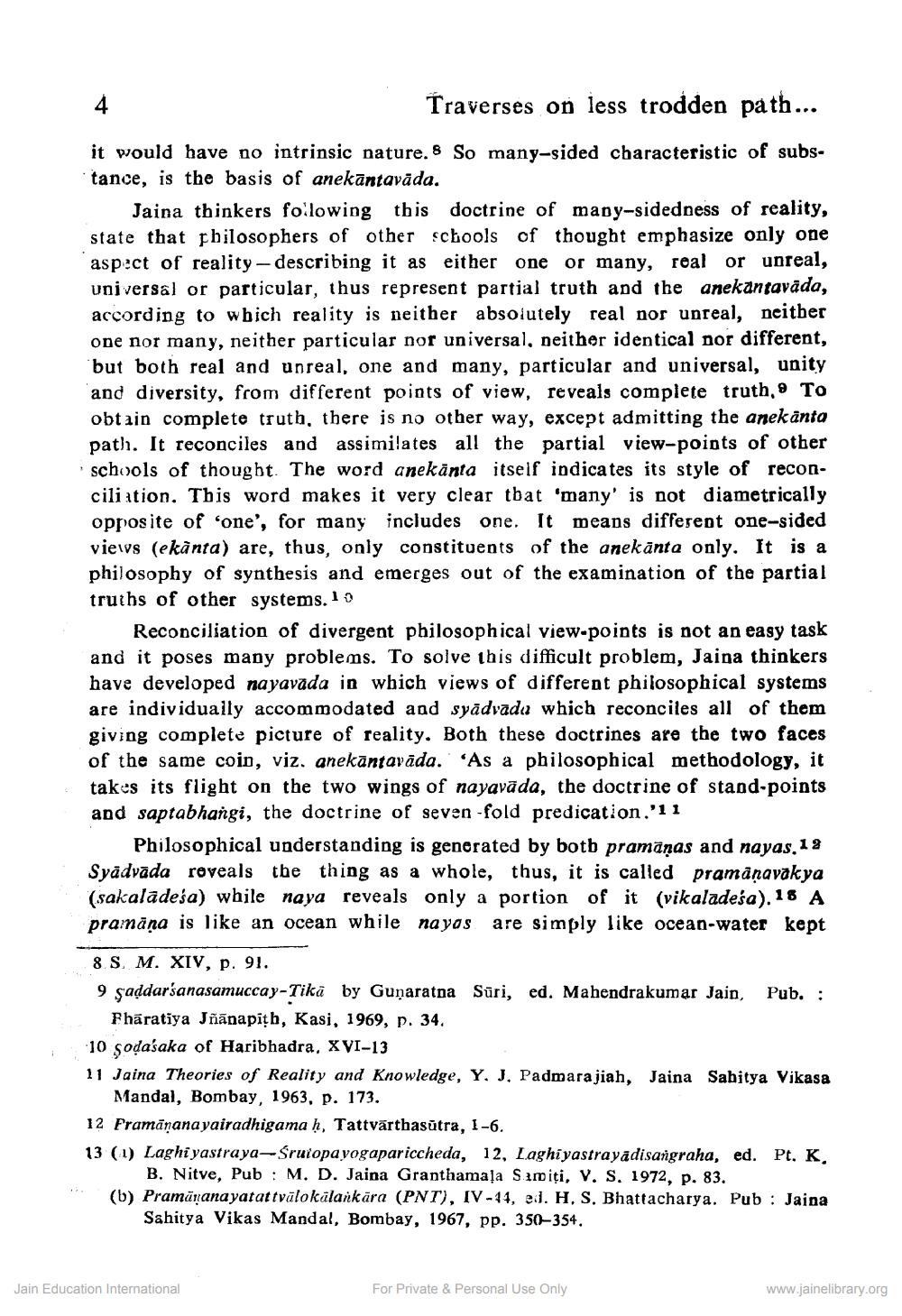________________
Traverses on less trodden path... it would have no intrinsic nature. 8 So many-sided characteristic of substance, is the basis of anekāntavāda.
Jaina thinkers following this doctrine of many-sidedness of reality, state that philosophers of other schools of thought emphasize only one aspect of reality-describing it as either one or many, real or unreal, universal or particular, thus represent partial truth and the anekantavāda, according to which reality is neither absolutely real nor unreal, neither one nor many, neither particular nor universal, neither identical nor different, but both real and unreal, one and many, particular and universal, unity and diversity, from different points of view, reveals complete truth, To obtain complete truth, there is no other way, except admitting the anekanta path. It reconciles and assimilates all the partial view-points of other schools of thought. The word anekanta itself indicates its style of reconciliation. This word makes it very clear that 'many' is not diametrically opposite of 'one', for many includes one. It means different one-sided views (ekānta) are, thus, only constituents of the anekanta only. It is a philosophy of synthesis and emerges out of the examination of the partial truths of other systems. 10
Reconciliation of divergent philosophical view-points is not an easy task and it poses many problems. To solve this difficult problem, Jaina thinkers have developed nayavada in which views of different philosophical systems are individually accommodated and syādvada which reconciles all of them giving complete picture of reality. Both these doctrines are the two faces of the same coin, viz. anekantavāda. As a philosophical methodology, it takes its flight on the two wings of nayavada, the doctrine of stand-points and saptabhangi, the doctrine of seven-fold predication.'11
Philosophical understanding is generated by botb pramāṇas and nayas, 12 Syadvāda reveals the thing as a whole, thus, it is called pramaṇavakya (sakaladeśa) while naya reveals only a portion of it (vikaladeśa). 18 A pramana is like an ocean while nayas are simply like ocean-water kept 8. S. M. XIV, p. 91.
9 şaḍdarsanasamuccay-Tika by Gunaratna Sūri, ed. Mahendrakumar Jain, Fharatiya Jñanapiṭh, Kasi, 1969, p. 34.
10 soḍasaka of Haribhadra, XVI-13
11 Jaina Theories of Reality and Knowledge, Y. J. Padmarajiah, Jaina Sahitya Vikasa Mandal, Bombay, 1963, p. 173.
Pub. :
12 Framāṇanayairadhigama ḥ, Tattvarthasutra, 1-6.
13 (1) Laghiyastraya-Śrutopayogapariccheda, 12, Laghiyastrayādisangraha, ed. Pt. K. B. Nitve, Pub M. D. Jaina Granthamala Samiti, V. S. 1972, p. 83. (b) Pramananayatattvālokālankära (PNT), IV-44, ed. H, S. Bhattacharya. Pub Jaina Sahitya Vikas Mandal, Bombay, 1967, pp. 350-354.
Jain Education International
For Private & Personal Use Only
www.jainelibrary.org




